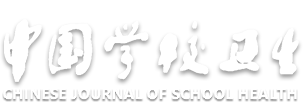Diarrhea caused by foodborne Salmonella infection in children aged 0-6 years in Guizhou Province from 2016 to 2023
-
摘要:
目的 分析贵州省2016—2023年0~6岁儿童食源性沙门菌感染腹泻情况和季节性分布特征,为防控食源性疾病提供依据。 方法 从食源性疾病病例监测系统中导出2016年1月1日至2023年12月31日上报至“食源性疾病病例监测系统”的贵州省0~6岁儿童感染病例,利用集中度法和圆形分布法对发病情况、季节性特征和高峰期进行分析。 结果 共采集6 434例0~6岁儿童腹泻病例,检出沙门菌455例,阳性检出率为7.07%,鼠伤寒沙门菌是引起腹泻的主要血清型(59.34%)。发病高峰期为5月3日至9月30日,具有一定的季节性特征。1~3岁年龄组腹泻病例沙门菌检出率最高(8.66%);食品种类中其他食品(17.39%)、水果类及其制品(10.22%)、婴幼儿食品(10.09%)及水产动物及其制品(9.80%)沙门菌阳性检出率较高,食品的加工和包装方式以家庭自制(9.38%)和散装食品(7.54%)为主。 结论 贵州省0~6岁儿童沙门菌感染率较高,季节性特征强,其他食品、水果类及其制品、婴幼儿食品及水产动物及其制品检出率较高,需对易感人群及高危暴露食品进行病原体监测,在夏秋季对儿童及监护人开展宣传教育。 Abstract:Objective To analyze the epidemilogical and seasonal characteristics of foodborne Salmonella-associated diarrhea among children aged 0-6 years in Guizhou Province from 2016 to 2023, so as to provide a basis for the prevention and control of foodborne diseases. Methods Data were extracted from the Foodborne Disease Survellance System for cases reported between January 1, 2016, and December 31, 2023. The incidence, seasonal characteristics, and peak periods were analyzed by the method of concentration and circular distribution. Results A total of 6 434 cases of diarrhea in children aged 0-6 years were collected, and 455 cases of Salmonella were detected, with a positive detection rate of 7.07%. Salmonella typhimurium was the main serotype causing diarrhea (59.34%). The peak of the disease was from May 3 to September 30, with certain seasonal characteristics. The highest detection rate was found in children aged 1-3 years (8.66%). Among food types, the positive detection rates of Salmonella were relatively high in other foods (17.39%), fruits and their products (10.22%), infant and toddler foods (10.09%), and aquatic animals and their products (9.80%). The processing and packaging methods of food were mainly home-made (9.38%) and bulk food (7.54%). Conclusions The detection rate of Salmonella in children aged 0-6 years is high in Guizhou Province, with strong seasonal characteristics. The detection rates of other foods, fruits and their products, infant and toddler foods, and aquatic animals and their products are high. Enhanced pathogen surveillance for susceptible populations and high-risk foods, coupled with public health education during summer/autumn, is recommended. -
Key words:
- Food /
- Salmonella infections /
- Diarrhea /
- Child, preschool
1) 利益冲突声明 所有作者声明无利益冲突。 -
表 1 贵州省2016—2023年0~6岁儿童沙门菌感染腹泻病例圆形分布法分析
Table 1. Analysis of circular distribution method for Salmonella infection diarrhea cases in children aged 0-6 years old in Guizhou Province from 2016 to 2023
年份 发病人数 Z值 P值 平均角ā/(°) 角标准差s/(°) 高峰日 高峰期 2016 33 6.84 < 0.01 194.35 71.87 7月15日 5月3日—9月27日 2017 49 6.80 < 0.01 173.89 80.53 6月24日 4月3日—9月15日 2018 29 9.38 < 0.01 165.31 60.87 6月16日 4月15日—8月17日 2019 33 9.68 < 0.01 233.79 63.46 8月25日 6月21日—10月28日 2020 44 16.52 < 0.01 185.47 56.71 7月6日 5月9日—9月3日 2021 110 31.87 < 0.01 209.57 63.77 7月31日 5月27日—10月4日 2022 56 8.50 < 0.01 179.13 78.66 6月30日 4月11日—9月18日 2023 101 12.56 < 0.01 199.35 82.73 7月20日 4月27日—10月13日 合计 455 88.55 < 0.01 195.98 73.30 7月17日 5月3日—9月30日 表 2 贵州省2016—2023年0~6岁患儿不同血清型沙门菌数量及构成比
Table 2. The number and composition ratio of different serotypes of Salmonella in children cases aged 0-6 in Guizhou Province from 2016 to 2023
年份 菌株数 鼠伤寒 肠炎 德尔卑 都柏林 乙型副伤寒 利齐菲尔德 里森 2016 33 20(60.61) 1(3.03) — 1(3.03) 2(6.06) — — 2017 49 30(61.22) 5(10.20) — 5(10.20) 3(6.12) — — 2018 29 15(51.72) 2(6.90) 1(3.45) 2(6.90) 2(6.90) — — 2019 33 22(66.67) 2(6.06) 3(9.09) — — — — 2020 44 20(45.45) 7(15.91) — — — — — 2021 110 61(55.45) 13(11.82) 5(4.55) 4(3.64) 1(0.91) 7(6.36) 4(3.64) 2022 56 33(58.93) 8(14.29) 2(3.57) — 2(3.57) — 1(1.79) 2023 101 69(68.32) 2(1.98) 3(2.97) — — 2(1.98) 3(2.97) 合计 455 270(59.34) 40(8.79) 14(3.08) 12(2.64) 10(2.20) 9(1.98) 8(1.76) 年份 菌株数 病牛 拉古什 鸡-雏 伦敦 斯坦利 未分型 其他血清型 2016 33 1(3.03) — 4(12.12) — — 2(6.06) 2(6.06) 2017 49 — — — 2(4.08) — 1(2.14) 3(6.12) 2018 29 1(3.45) — — — — 4(13.79) 2(6.90) 2019 33 — — — — — 4(12.12) 2(6.06) 2020 44 — — — — 1(2.27) 10(22.73) 6(13.64) 2021 110 — 4(3.64) — 1(0.91) 1(0.91) 1(0.91) 8(7.27) 2022 56 2(3.57) — — — 1(1.79) 1(1.79) 6(10.71) 2023 101 3(2.97) 1(0.99) — 1(0.99) 1(0.99) — 16(15.84) 合计 455 7(1.54) 5(1.10) 4(0.88) 4(0.88) 4(0.88) 23(5.05) 45(9.89) 注:()内数字为构成比/%。 表 3 贵州省2016—2023年0~6岁儿童阳性病例的可疑暴露食品分布情况
Table 3. Distribution of suspected exposure to food among positive cases of 0-6-year-old children in Guizhou Province from 2016 to 2023
年份 菌株数 乳与乳制品 粮食类及其制品 多种食品 水果类及其制品 混合食品 蛋与蛋制品 肉与肉制品 样本数 阳性数 样本数 阳性数 样本数 阳性数 样本数 阳性数 样本数 阳性数 样本数 阳性数 样本数 阳性数 2016 33 161 7(4.35) 87 4(4.60) 69 7(10.14) 20 — 31 8(25.81) 13 5(38.46) 13 — 2017 49 241 6(2.49) 116 17(14.66) 125 17(13.60) 20 4(20.00) 10 1(10.00) 4 — 7 — 2018 29 322 10(3.11) 110 5(4.55) 134 10(7.46) 30 1(3.33) 22 2(9.09) 4 — 6 1(16.67) 2019 33 301 10(3.32) 99 9(9.09) 119 9(7.56) 22 2(9.09) 38 1(2.63) 3 1(33.33) 6 — 2020 44 298 21(7.05) 162 8(4.94) 81 4(4.94) 49 2(4.08) 67 4(5.97) 17 2(11.76) 11 1(9.09) 2021 110 345 31(8.99) 339 29(8.55) 64 5(7.81) 150 18(12.00) 131 14(10.69) 39 2(5.13) 38 3(7.89) 2022 56 309 10(3.24) 271 27(9.96) 83 2(2.41) 102 10(9.80) 60 1(1.67) 40 — 23 — 2023 101 262 25(9.54) 325 25(7.69) 123 7(5.69) 116 15(12.93) 135 9(6.67) 57 6(10.53) 49 4(8.16) 合计 455 2 239 120(5.36) 1 509 123(8.15) 798 61(7.64) 509 52(10.22) 494 40(8.10) 177 17(9.60) 153 9(5.88) 年份 菌株数 蔬菜类及其制品 婴幼儿食品 饮料与冷冻饮品类 水产动物及其制品 豆与豆制品 其他食品 样本数 阳性数 样本数 阳性数 样本数 阳性数 样本数 阳性数 样本数 阳性数 样本数 阳性数 2016 33 17 1(5.88) 12 — 5 1(20.00) 1 — 5 — 1 — 2017 49 9 1(11.11) 16 2(12.50) 1 — 6 — 1 — 7 1(14.29) 2018 29 10 — 15 — 1 — 2 — 5 — 2 — 2019 33 7 1(14.29) 2 — 3 — 4 — 1 — 2 — 2020 44 20 1(5.00) 6 1(16.67) 6 — 5 — 5 — 1 — 2021 110 27 1(3.70) 16 3(18.75) 10 — 11 1(9.09) 8 — 4 2(50.00) 2022 56 17 — 27 3(11.11) 17 1(5.88) 10 1(10.00) 8 1(12.50) 4 — 2023 101 34 2(5.88) 15 2(13.33) 8 2(25.00) 12 3(25.00) 5 — 2 1(50.00) 合计 455 141 7(4.96) 109 11(10.09) 51 4(7.84) 51 5(9.80) 38 1(2.63) 23 4(17.39) 注:()内数字为阳性检出率/%。 -
[1] 全国人民代表大会常务委员会. 中华人民共和国食品安全法[N]. 人民日报, 2016-03-18(19).Standing Committee of the National People's Congress. Food safety law of the PRC[N]. People's Daily Online, 2016-03-18(19). (in Chinese) [2] KIRK M D, PIRES S M, BLACK R E, et al. World health organization estimates of the global and regional disease burden of 22 foodborne bacterial, protozoal, and viral diseases, 2010: a data synthesis[J]. Plos Med, 2015, 12(12): e1001920. doi: 10.1371/journal.pmed.1001920 [3] 韩毅, 沙丹, 张娜娜, 等. 2017—2020年江苏省无锡市沙门菌的血清型与耐药性研究[J]. 中国食品卫生杂志, 2022, 34(6): 1172-1177.HAN Y, SHA D, ZHANG N N, et al. Study on the serotype and drug resistance of salmonella in Wuxi City, Jiangsu Province from 2017 to 2020[J]. Chin J Food Hyg, 2022, 34(6): 1172-1177. (in Chinese) [4] 王吉晓, 马永忠, 王瑞, 等. 2013—2022年海南省0-6岁儿童食源性疾病特征及影响因素分析[J]. 中国公共卫生, 2024, 40(4): 436-441.WANG J X, MA Y Z, WANG R, et al. Incidence and determinants of foodborne diseases among children aged 0-6 years in Hainan Province from 2013 to 2022: an analysis of active surveillance data[J]. Chin J Public Health, 2024, 40(4): 436-441. (in Chinese) [5] 李翠华, 孙妍兰. 2013—2022年青海省西宁市手足口病季节性特征分析[J]. 疾病监测, 2024, 39(9): 1157-1162.LI C H, SUN Y L. Seasonal characteristics of hand, foot and mouth disease in Xining, Qinghai, 2013-2022[J]. Dis Surveill, 2024, 39(9): 1157-1162. (in Chinese) [6] 彭淑萍, 李波, 廖国东, 等. 广东省茂名市儿童食源性沙门菌感染的血清型分型和耐药特征[J]. 中国热带医学, 2020, 20(7): 661-665.PENG S P, LI B, LIAO G D, et al. Serotyping and drug resistance of food-borne Salmonella in children in Maoming, Guangdong[J]. China Torp Med, 2020, 20(7): 661-665. (in Chinese) [7] 江晓, 杜雪飞, 叶艳华, 等. 2015—2016年南京地区儿童感染性腹泻病原学监测结果分析[J]. 实用预防医学, 2018, 25(12): 1508-1510. doi: 10.3969/j.issn.1006-3110.2018.12.029JIANG X, DU X F, YE Y H, et al. Analysis of etiological surveillance results of infectious diarrhea in children in Nanjing from 2015 to 2016[J]. Pract Prev Med, 2018, 25(12): 1508-1510. (in Chinese) doi: 10.3969/j.issn.1006-3110.2018.12.029 [8] 聂丽, 邓颖, 罗万军, 等. 2017—2022年武汉地区儿童食源性疾病监测沙门氏菌感染情况和耐药性分析[J]. 中国人兽共患病学报, 2024, 40(8): 750-757.NIE L, DENG Y, LUO W J, et al. Salmonella infection and drug resistance in foodborne disease surveillance among children in Wuhan from 2017 to 2022[J]. Chin J Zoonoses, 2024, 40(8): 750-757. (in Chinese) [9] 张楚, 王晨蕾, 殷荣荣, 等. 2020—2021年云南省食源性沙门氏菌感染腹泻流行病学特征分析[J]. 中国人兽共患病学报, 2024, 40(2): 111-115.ZHANG C, WANG C L, YIN R R, et al. Epidemiological characterization of diarrhea due to food-borne Salmonella infection in Yunnan Province from 2020 to 2021[J]. Chin J Zoonoses, 2024, 40(2): 111-115. (in Chinese) [10] 黄会金, 彭思露, 周厚德, 等. 2016—2018年江西省食源性腹泻患者沙门氏菌感染状况和耐药性分析[J]. 现代预防医学, 2020, 47(24): 4452-4455.HUANG H J, PENG S L, ZHOU H D, et al. Prevalence and drug resistance of Salmonella isolated from diarrhea patients in Jiangxi Province in 2016-2018[J]. Mod Prev Med, 2020, 47(24): 4452-4455. (in Chinese) [11] 肖巍, 李想, 罗君. 2018—2020年河南省开封市儿童食源性沙门氏菌感染监测分析[J]. 现代疾病预防控制, 2022, 33(5): 397-400.XIAO W, LI X, LUO J. Surveillance and analysis of foodborne Salmonella infection among children in Kaifeng City of Henan Province from 2018 to 2020[J]. Mod Dis Control Prev, 2022, 33(5): 397-400. (in Chinese) [12] 张阳, 兰光, 张璟, 等. 2019—2021年甘肃省食源性疾病患者沙门菌感染状况和耐药性分析[J]. 疾病监测, 2023, 38(6): 707-713.ZHANG Y, LAN G, ZHANG J, et al. Salmonella infection and drug resistance in patients with foodborne disease in Gansu, 2019-2021[J]. Dis Surveill, 2023, 38(6): 707-713. (in Chinese) [13] 刘雪杰, 陈伟伟, 傅祎欣, 等. 2015—2018年福建省食源性疾病沙门氏菌监测情况分析[J]. 中国人兽共患病学报, 2020, 36(3): 223-228.LIU X J, CHEN W W, FU Y X, et al. Surveillance situation of Salmonella in food borne diseases in Fujian, China, 2015-2018[J]. Chin J Zoonoses, 2020, 36(3): 223-228. (in Chinese) [14] 石亚锋, 张建群, 符凌辉, 等. 2015—2020年浙江省余姚市沙门菌感染流行特征分析[J]. 疾病监测, 2023, 38(2): 185-190.SHI Y F, ZHANG J Q, FU L H, et al. Epidemiological characteristics of Salmonella infection in Yuyao, Zhejiang, 2015-2020[J]. Dis Surveill, 2023, 38(2): 185-190. (in Chinese) -

 点击查看大图
点击查看大图
计量
- 文章访问数: 7
- HTML全文浏览量: 4
- PDF下载量: 0
- 被引次数: 0





 下载:
下载: